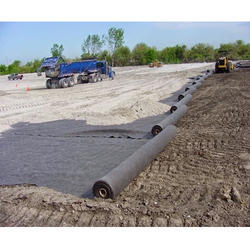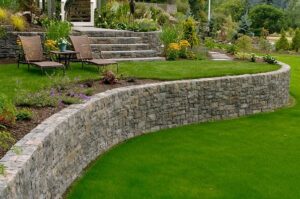5 Types of Geotextiles, Functions And Its Uses In Construction

Over the last fifteen years, geotextiles have grown more popular as a type of geosynthetic material. The material’s biodegradation resistance is a key reason for its success in more than 80 applications. Geotextiles are fabrics in the usual sense, but not in the way you might think. Natural fibers such as cotton, wool, and silk are not used. Geotextiles are synthetic fibers that may be manufactured into a nonwoven needlefelt fabric that is flexible and porous. To varying degrees, they are permeable to water movement.
Geotextiles are permeable fabrics made from synthetic or natural fibers. They are designed to be placed in contact with soil or rock to improve their strength and stability. Moreover, they are commonly used to prevent soil erosion, filter water, and separate different layers of soil or rock.
Geomembranes and geotextiles are two types of geosynthetics that are commonly used for earth reinforcement. They are commonly made from materials such as high-density polyethene (HDPE), polypropylene (PP), and polyvinyl chloride (PVC) and are available in various thicknesses and strengths.
Using geomembranes and geotextiles for earth reinforcement creates a barrier to prevent water or other liquids from moving through the soil, which can lead to erosion and instability. They can also be used to line containment structures such as landfills and ponds. Also, there are many more uses, functions, and types of a geotextile, so keep reading to know more!
Table of Contents
What Are the 5 Common Types Of Geotextiles?
Geotextiles are permeable OR natural fabrics used for various civil engineering applications. Here are 5 most common types:
- Woven geotextiles: These are made by weaving synthetic fibers together to create a robust and durable fabric. They are commonly used for applications that require high tensile strength and puncture resistance, such as underlayment for roads and railways, erosion control, and reinforcement of retaining walls.
- Non-woven geotextiles: They are made by bonding synthetic fibers together without weaving them. They are commonly used for applications that require good water permeability, such as drainage systems, filtration, and separation of different layers of soil or rock.
- Needle-punched geotextiles: Needle-punched geotextile is made by mechanically punching and compacting fibers together. They are commonly used for applications that require good strength and filtration properties, such as erosion control, drainage systems, and soil stabilization.
- Composite geotextiles: They are made by combining two or more types of geotextiles to create a material with unique properties. For example, a composite geotextile may combine a non-woven geotextile with a woven geotextile to create a strong, durable, and highly permeable material.
- High-strength geotextiles: These are designed to provide exceptional tensile strength and puncture resistance. They are commonly used for applications requiring very high loads, such as reinforcing roadways, railways and retaining walls.
Though specific engineering and site conditions will determine which type of geotextile is used for a particular application.
What Are The Top 5 Functions And Uses Of Geotextile In Construction?
Geotextiles are commonly used in construction for a wide range of applications due to their ability to improve the performance and durability of soil and structures. The use of geomembranes and geotextiles for earth reinforcement is one of its uses. Here are the top 5 uses of geotextiles in construction:
- Separation: They are used to separate different layers of soil or rock, preventing mixing and contamination. This is especially important in applications such as road construction, where the subgrade soil may be weaker than the base material.
- Filtration: Geotextiles are used to filter water and prevent fine soil particles from migrating. This is important for drainage systems, as it helps maintain the water flow while preventing soil particles from clogging the system.
- Reinforcement: They are used to reinforce soil and structures, improving their strength and stability. This is commonly used in applications such as retaining walls, slope stabilization, and road construction.
- Erosion control: Geotextiles are used to prevent erosion of soil and structures, protecting against natural forces such as wind and water. This is important for applications such as shoreline protection, channel lining, and embankment stabilization.
- Protection: They are used to protect structures from damage caused by soil and environmental factors. For example, using geomembranes and geotextiles for earth reinforcement, using a geotextile to protect the waterproof membranes in structures such as landfills, or protecting underground utilities from damage caused by soil movement.
Get In Touch With Ocean Global To Buy Top-quality Geotextiles!
Ocean Global are one of this business’s most prominent and leading pioneers. You can easily use our geomembranes and geotextiles for earth reinforcement purposes. Our professional team engineers make products that are tailored to specific requirements and site conditions, taking into account factors such as soil type, climate, and anticipated loads. As demand for geotextiles continues to grow we explore new materials and production techniques to further enhance our products and meet the evolving needs of the construction industry.
Top Geo textile Manufacturers and Suppliers in India
Ocean Global, one of India’s top geotextile manufacturers, offers a healthy and long-lasting Geotextile line that is stitch-free and available in a variety of colors and lengths to fit the clients’ demands.
Ocean Global, located in New Delhi, was formed in 1998 and is India’s leading provider of ecologically friendly engineering solutions. Ocean Global is recognized for its innovative geosynthetic and engineering solutions that handle a wide range of soil-related problems on construction sites.
For both local and foreign markets, Ocean Global’s nonwoven geotextile product range is quality certified to the highest production standards in ISO-accredited quality facilities. The polyester continuous filament nonwoven geotextile is available from Ocean Global in a range of weights, strengths, and filtering properties.
FAQs
What types of materials are used to make geotextiles?
A geotextile is made from a variety of materials, including polypropylene, polyester, nylon, and natural fibers such as jute or coir.
What factors are considered when selecting a geotextile for a project?
When selecting a geotextile for a project, factors such as soil type, anticipated loads, and environmental conditions are typically considered.
How are geotextiles installed in a project?
A geotextile can be installed using a variety of techniques, including laying them directly on the surface of the soil or embedding them within the soil layers. Installation methods will depend on the specific application and site conditions.
What are some standard functions of a geotextile?
Some standard functions of a geotextile include separation, filtration, reinforcement, erosion control, and protection.
What are geomembranes used for?
An earthen geomembrane is a giant waterproof membrane made from reinforced polymer materials that provide natural soil stabilization and landfill security, ensuring hazardous or municipal waste is contained.



